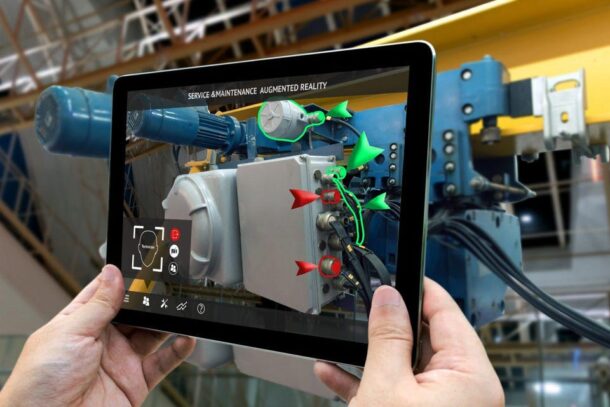Are you tired of managing your contracting business the old-fashioned way? Do you want to streamline your operations, improve communication with clients, and increase productivity? Look no further than these 5 must-have technologies that can revolutionize the way you do business. From project management software to drones and virtual reality, these tools can help you Read more
Mobile Devices

Are you tired of managing your contracting business the old-fashioned way? Do you want to streamline your operations, improve communication with clients, and increase productivity? Look no further than these 5 must-have technologies that can revolutionize the way you do business. From project management software to drones and virtual reality, these tools can help you stay ahead of the competition and provide unparalleled service to your customers. In today’s fast-paced digital world, it’s essential to embrace technology to remain relevant and efficient. So, if you’re ready to take your contracting business to the next level, read on to discover how these cutting-edge technologies can help you achieve your goals.
Technology #1: Project Management Software
One of the most crucial aspects of running a successful contracting business is effective project management. With project management software, you can streamline the entire process, from initial planning to final delivery. These tools typically provide a centralized platform for communication, document sharing, and progress tracking. This can help you stay on top of your projects and ensure that everything is completed on time and within budget.
In addition to improving project management, using home services software can also help you communicate more effectively with clients. You can use the software to share progress updates, timelines, and budget information, keeping your clients in the loop and building trust. And with features like task assignments and automatic reminders, you can make sure that everyone involved in the project knows what they need to do and when they need to do it.

Technology #2: Mobile Devices and Apps
In today’s fast-paced world, it’s essential to be able to work on the go. That’s where mobile devices and apps come in. With a smartphone or tablet, you can stay connected to your business and your clients no matter where you are.
Some apps allow you to create professional-looking quotes and invoices on the go, as well as track your time and expenses. You can also use it to schedule appointments and send reminders to clients. Other useful apps may enable your team to access and annotate blueprints on their mobile devices, while also tracking safety inspections and compliance.
But it’s not just about the apps – you also need the right devices to run them on. When choosing a mobile device, consider factors like battery life, screen size, and durability. And make sure that the device is compatible with the apps you may already use. With the right mobile devices and apps, you can stay connected and productive no matter where your work takes you.
Technology #3: Drones and 3D Modeling
Drones and 3D modeling are revolutionizing the way contractors approach projects. With a drone, you can capture high-quality aerial footage of a site, allowing you to get a better understanding of the terrain and any potential challenges. Drones are particularly useful for large-scale projects like construction sites and land surveys.
With 3D modeling software, you can create detailed models of a project before it even begins, allowing you to identify potential issues and make adjustments before the work starts. And with features like clash detection, you can ensure that all elements of the project are compatible and will work together seamlessly.
It is important to note that drones are subject to FAA regulations, and you may need a license to operate them. Also, 3D modeling software can be complex and time-consuming to use. Fortunately, with the right training and support, these technologies can help you take your contracting business to the next level.

Technology #4: Virtual and Augmented Reality
Virtual and augmented reality are still relatively new technologies, but they’re already significantly impacting the construction industry. With virtual reality (VR), you can create immersive 3D environments that allow clients to experience a project before the work is in progress. And with augmented reality (AR), you can overlay digital information onto the real world, allowing you to see how a project will fit into its surroundings.
Virtual reality can be particularly useful for large-scale projects like commercial buildings or housing developments. With a virtual reality headset, a client can “walk through” a project and get a sense of the space and layout. This can help them make more informed decisions and feel more confident in their investment.
Augmented reality, on the other hand, can be useful for smaller-scale projects like home renovations. With AR, you can overlay digital information onto the real world, allowing you to see how different materials or colors will look in a space. This can help you make more informed decisions and ensure that your clients are happy with the final result.
With any new technology, there are challenges to consider. Virtual and augmented reality can be expensive to implement, and there may be a learning curve for both you and your clients. However, as these technologies become more widespread, they may become essential tools for contractors looking to stay ahead of the competition.
Technology #5:
Smart home automation is becoming increasingly popular among homeowners, and contractors who can offer these services are in high demand. With smart home automation, you can control everything from lighting to thermostats with a simple voice command or mobile app. This can make a home more comfortable, energy-efficient, and secure.
Smart home automation can be particularly useful for contractors who specialize in home renovations or new construction. By offering smart home automation as an add-on service, you can differentiate yourself from the competition and provide additional value to your clients.
You may need to partner with an experienced home automation company to ensure that everything is installed and configured correctly. And you’ll need to stay up to date with the latest technologies and trends to ensure that you’re offering the best possible service to your clients.
Challenges of Implementing These Technologies and How to Overcome Them
Implementing new technologies can be a challenge, but with the right approach, you can overcome these challenges. Here are a few common challenges and how to address them:
- Cost: Many of these technologies can be expensive to implement, but you can offset the cost by charging higher rates for your services or by offering them as add-on services.
- Training: It’s important to take the time to train yourself and your team on how to use these technologies effectively. Consider partnering with a technology vendor or hiring a consultant to provide training and support.
- Resistance to change: Some team members or clients may be resistant to new technologies. It’s important to communicate the benefits of these technologies and demonstrate how they can improve your business and the client experience.
Cost Considerations for Technology Implementation
The cost of implementing these technologies can vary widely depending on the specific tools you choose and the size of your business. Here are a few cost considerations to keep in mind:
- Subscription fees: Most project management software tools and apps require a monthly or annual subscription fee.
- Equipment costs: Drones, 3D modeling software, and virtual reality headsets can be expensive. Be sure to research your options so you can ensure the most useful and cost-effective technology is being implemented.
- Training and support: If you need to hire a consultant or partner with a technology vendor to provide training and support, this service will come at a cost to your business.
When considering the cost of implementing these technologies, it’s important to weigh the potential benefits against the cost. In many cases, these technologies can provide a significant return on investment by improving productivity, increasing profits, and enhancing the client experience.
Final Thoughts
Implementing these five technologies can help you take your contracting business to the next level. By improving project management, staying connected on the go, leveraging drones and 3D modeling, embracing virtual and augmented reality, and offering smart home automation, you can differentiate yourself from the competition and provide unparalleled service to your clients.
